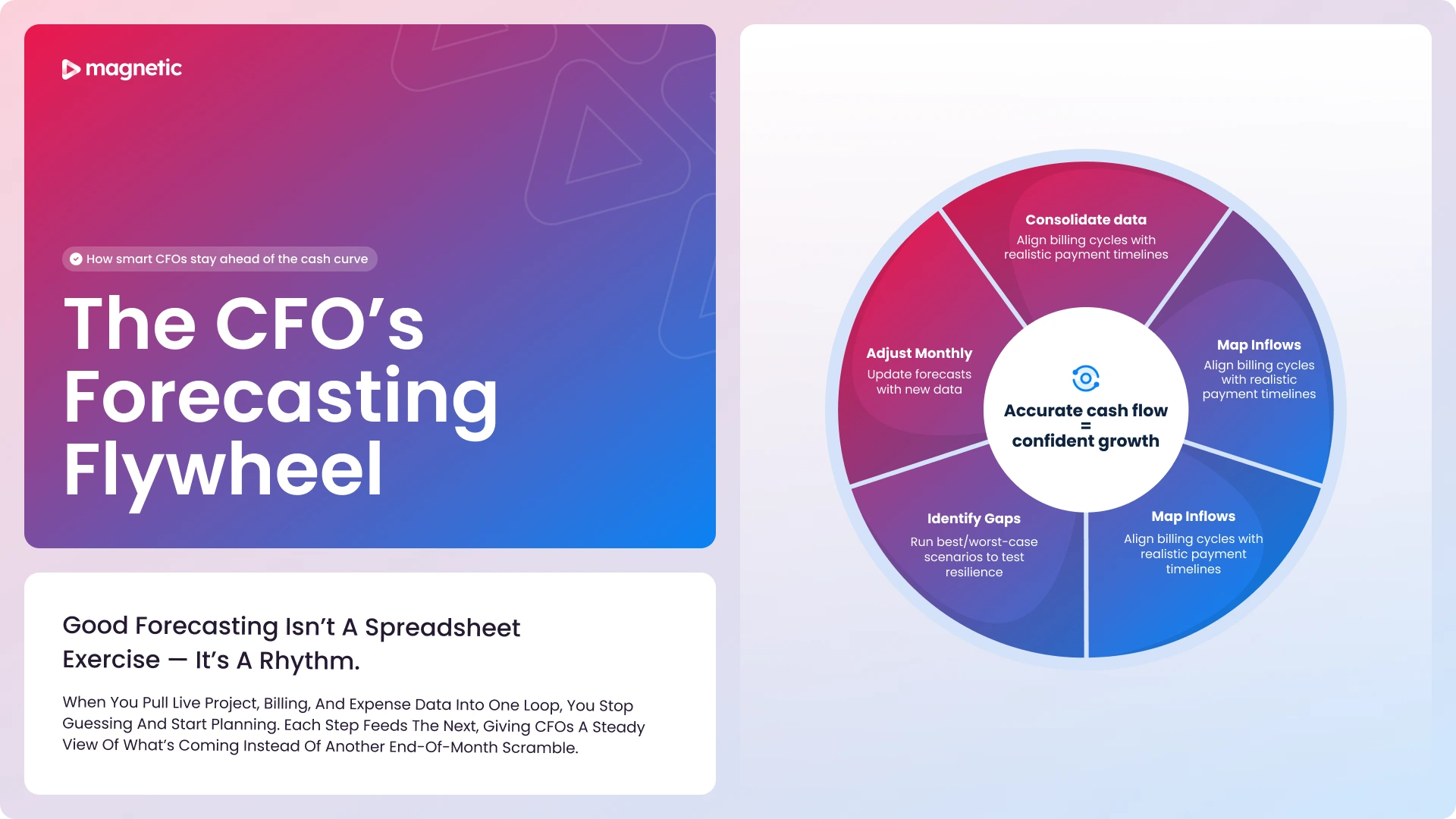Table of contents
Subscribe to our newsletter
Thank you! Your submission has been received!
Oops! Something went wrong while submitting the form.


For small professional services firms, cash flow is rarely predictable. Projects bill at odd times, expenses never take a break, and one late client payment can send your entire business into a spin. For CFOs, the answer lies in cash flow forecasting for professional services. Get it right and you can plan for growth, allocate resources with confidence, and avoid those stomach-dropping surprises when the numbers don’t add up.
Key Insights We’ll Cover in This Piece
For small professional services firms, cash flow forecasting is rarely straightforward. Unlike product businesses that bill at the point of sale, project-based firms have to juggle irregular billing cycles, unpredictable client behaviour, and expenses that never end. It creates a constant tension between money going out on schedule and money coming in whenever it feels like it.
One of the hardest pressures CFOs face is irregular project billing. Milestone invoices may land weeks or even months apart, making it tricky to line up inflows with the steady stream of outflows. Add to that the reality of client payment delays, and a forecast that looked healthy on paper can suddenly turn into a shortfall.
Meanwhile, overheads are relentless. Salaries, office costs, software subscriptions, and supplier payments tick over no matter what is happening with client projects. For CFOs, this means cash flow forecasting for professional services is less about predicting a neat monthly pattern and more about managing the bumps and gaps along the way.
The real challenge is not just keeping the lights on, but taking a more strategic role.
With accurate forecasting, CFOs can see trouble brewing weeks in advance, rather than reacting once the bank balance dips. That visibility makes it possible to plan resourcing, time investments, or even line up financing if a gap is unavoidable. In other words, forecasting turns the CFO from a firefighter into the navigator who keeps the firm on course, no matter how unpredictable the projects become.
For small professional services firms, inaccurate forecasting carries two kinds of risk: the immediate hits that show up in the bank balance, and the longer-term damage that stifles growth.
When the numbers are off, the direct risks appear quickly:
Looking further ahead, the strategic risks can be even more damaging:
The consequences can be serious even for firms that look profitable on paper. Take a 25-person architecture practice for example:
If just two major invoices are delayed by a month, the shortfall could equal a full payroll cycle. Without accurate cash flow forecasting for professional services, the CFO is left scrambling to plug the gap instead of steering the business forward.
In professional services, cash flow forecasting only works if the data feeding it is accurate and up to date. Relying on static spreadsheets stitched together once a month leaves CFOs reacting to old information. What you need instead is a live, integrated view of the factors that really drive cash flow.
The first input is the project pipeline and timelines.
The second is the billing schedules and receivables.
The third is resource utilisation and labour costs.
The fourth is overheads and fixed expenses.
When all of these inputs sit in one integrated system, CFOs gain the financial visibility that spreadsheets cannot provide. Instead of patching together outdated figures, they can see live inflows and outflows and produce forecasts that truly guide decision-making.
Cash flow forecasting for professional services firms becomes far more manageable when broken into a clear process. Rather than relying on gut feel or patchy spreadsheets, CFOs can follow a structured approach that delivers both clarity and confidence.
Start by bringing together the essentials: project schedules, billing information, and expenses. Having everything in one place eliminates the guesswork that comes from juggling different systems or out-of-date spreadsheets.
Line up billing schedules with when you actually expect payment. Contracts may say “30 days” but if a client typically takes 45, your forecast should reflect reality, not optimism. This view of receivables is the backbone of reliable forecasting.
List every regular cost that leaves the business. Salaries, rent, software subscriptions, and subcontractor fees all need to be included. Remember that overheads rarely shift, so it is inflows that must flex around them.
Once inflows and outflows are mapped, test the forecast against best and worst-case scenarios. What happens if one major invoice arrives late? Can the firm still cover payroll? Stress-testing helps CFOs prepare rather than panic.
Forecasts are not set-and-forget documents. Update them regularly with real-time project and billing data. A rolling forecast keeps the picture accurate and helps CFOs make decisions before problems arise.

A quick scenario
Take a 20-person consulting firm with £300,000 in annual overheads. In April, two invoices worth £50,000 each are due. If both land on time, the month ends in surplus. If one arrives six weeks late, the firm suddenly faces a £50,000 shortfall that eats into reserves and jeopardises payroll. With proper cash flow forecasting, the CFO can spot this early and decide whether to slow hiring, arrange temporary financing, or push harder on collections.
What would that cash flow look like?
Manual forecasting might work when a firm is small and running just a handful of projects, but it quickly breaks down as the business grows. Spreadsheets are slow to update, prone to mistakes, and never quite show what is coming next. For scaling firms, this creates more risk than reassurance.
Why manual forecasting fails:
What software does differently:
The shift is not just about speed but about accuracy and confidence. With cash flow software for professional services firms, CFOs gain visibility into what lies ahead, not just what has already happened. Instead of chasing numbers across disconnected spreadsheets, they can focus on making decisions that protect stability and support growth.
For firms ready to move beyond reactive cash flow forecasting for professional services, software is not really optional anymore. It has become the backbone of reliable financial planning.
All the theory of forecasting only becomes useful when it is backed by the right tools. This is where Magnetic comes in. Built for small professional services firms, it pulls together the moving pieces that usually sit in different systems and makes them work as one. The result is a level of visibility that spreadsheets can never match.
Here’s what Magnetic delivers for CFOs:
With Magnetic, professional services firms move from reactive forecasting to proactive planning. Instead of finding out too late that a shortfall is coming, CFOs can model different scenarios and act early, whether that means adjusting hiring plans, renegotiating payment terms, or timing investments more strategically.
Cash flow forecasting for professional services firms is about more than keeping the numbers tidy. It is about giving the business the breathing room to grow. When inflows and outflows are unpredictable, it is easy to slip into a cycle of reacting to problems instead of planning ahead. With the right approach, CFOs can turn that uncertainty into a clear picture of what lies ahead.
The essentials are straightforward. Forecasts work best when all the moving parts are connected in one place, like projects, billing, resources, and overheads. That visibility allows CFOs to spot gaps before they cause trouble and to test scenarios before committing to big decisions. It is the shift from reactive reporting to proactive planning, and it gives firms the confidence to hire, invest, and expand without second-guessing the bank balance.
If you want to see what that looks like in practice, book a demo and discover how Magnetic can make cash flow forecasting both accurate and actionable.
The most reliable approach is to connect project timelines, billing schedules, and overheads in one place. Spreadsheets can give a snapshot, but they miss the bigger picture. A system that reflects real project milestones and client payment behaviour will always give CFOs a truer view of what lies ahead.
.svg)
Forecasts should be reviewed at least once a month, with adjustments made whenever projects shift or invoices are delayed. The more frequently forecasts are updated with real-time data, the less chance there is of being caught out by surprise gaps.
.svg)
Yes. And for most growing firms it should. Spreadsheets are prone to version errors and delays, while cash flow software for professional services firms automatically pulls in live project, billing, and expense data. That means forecasts aren’t just accurate, they’re current.
.svg)
Magnetic is built to sit alongside popular accounting platforms, feeding live project and billing data directly into forecasts. This ensures CFOs get the strategic visibility of project-driven inflows and outflows, while still keeping the general ledger intact in their existing system.
.svg)
Because projects don’t pay like clockwork, while overheads never stop. Forecasting turns that uncertainty into something predictable. It gives CFOs the confidence to plan growth, secure staff, and invest in new opportunities without fearing a sudden shortfall.
.svg)
Relying on averages rather than actual project and client data. Many forecasts assume invoices will be paid on time or that project timelines wont shift, but in reality the often do. The most accurate forecasts are built on live, connected data that reflects how work and payment really happen.